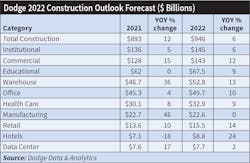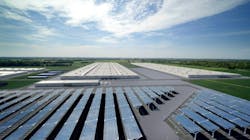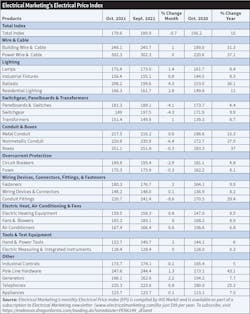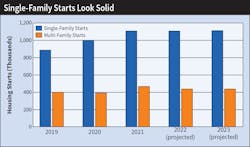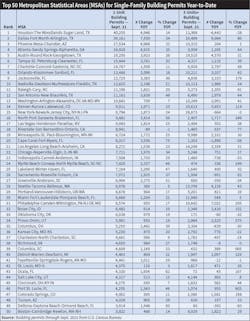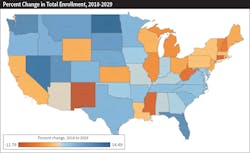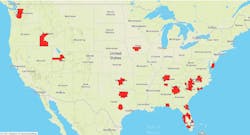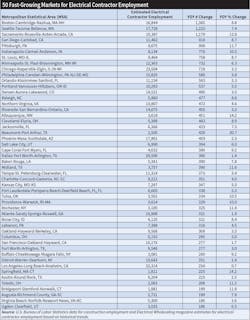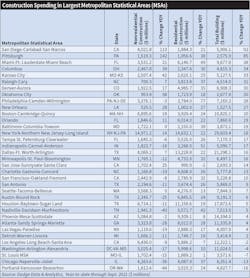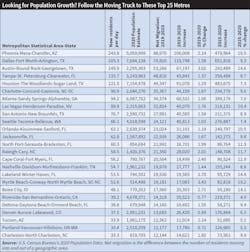What a difference a year makes. At this time last year, the economy was still climbing out of a huge hole from the pandemic. Vaccines for COVID-19 had not yet hit the market, and cases were spiking. Mask restrictions were everywhere, and access to job sites was uncertain in many areas of the country. We were also all spending way too many hours on Zoom meetings.
Thankfully, we have a better handle on COVID-19 today than we did 12 months ago. The global economy is also on a more solid footing than it was in 4Q 2020, and the overall expectations of many economists for U.S. GDP growth are in the 4% to 5% range. Job sites are open and face-to-face meetings with co-workers, suppliers, and customers are becoming more common. The recently passed Infrastructure Bill is also expected to provide some real financial benefits for the electrical construction industry.
The 2022 construction forecast all adds up to what should be a decent year for electrical contractors, facility maintenance workers, and other electrical professionals. Some niches within the construction market will provide more business than others, and some regions of the United States will be loaded with work, while others will be quieter. This article will help you identify the most promising market areas in 2022 for your business.
National view
On a national basis, several of the best-known construction economists expect steady, if not spectacular, growth for next year. Two of our favorite annual construction forecasts are published by Richard Branch, chief economist for Dodge Data & Analytics, and Kermit Baker, chief economist for the American Institute of Architects (AIA).
At the 2022 Dodge Construction Outlook, Branch said he expects total construction to increase 6% in 2022 to $946 billion after a 12% increase in 2021 (Table 1). He cautioned webinar attendees at the annual forecast conference that although the construction market will grow next year, product pricing, material shortages, and worker shortages will be some of the biggest issues. Branch is looking for the biggest increases in spending on construction starts in the following areas:
- Commercial: 12% to $143 billion
- Warehouses: 13% to $52.8 billion
- Offices: 10% to $49.7 billion
- Retail: 14% to $15.5 billion
- Hotels: 24% to $8.8 billion
He said in a recent press statement that although U.S. economic growth has resumed after a slowdown in 3Q 2021 because of the resurgence of the Delta variant of the coronavirus, “the construction sector’s grip on growth remains tenuous.”
“Long term, construction starts should improve, fed by an increase of nonresidential building projects in the planning pipeline and the recent passage of the Infrastructure Bill,” he said in the release. “Both will provide meaningful support and growth to construction in the year to come. This expectation, however, must be tempered by the significant challenges facing the industry: high prices, shortages of key materials, and the continued scarcity of skilled labor. While healing from the pandemic continues, there’s still a long road back to full recovery.”
AIA’s Baker is optimistic about the construction industry’s fortunes in 2022. He says AIA architects are seeing more demand for retrofit work. “Even prior to the pandemic, architecture firms were reporting that almost half of their billings, on average, resulted from renovations, rehabilitations, retrofits, additions, and historic preservation projects on the existing building stock,” he said in a post about AIA’s Consensus Construction Forecast. “This was before concerns developed regarding how buildings could be made safer for employees and customers with heightened health concerns.
“After declining about 2% last year, the AIA Consensus Construction Forecast Panel in its mid-year update is projecting that spending on nonresidential buildings will decline an additional 3.9% in 2021 — an upgrade from the 5.7% decline forecast at the beginning of the year — and that 2022 will see a 4.6% increase in spending. The strongest performers this year are expected to be health care facilities (1.4%), and a few others should see only modest declines — retail (1.3%); religious (0.9%); and education (2.1%). However, in 2022 virtually all the nonresidential building sectors are expected to see healthy growth, paced by lodging, as well as amusement and recreation, both of which saw steep declines during the pandemic.”
Next year’s challenges
Following are some of the obstacles electrical construction professionals will have to navigate in the coming year in order to stay competitive.
Skyrocketing product prices. Double-digit year-over-year (YOY) price increases for electrical products are common this year, according to Electrical Marketing’s Electrical Price Index, which analyzes monthly and year-over-year price increases for more than 20 electrical products (Table 2). The largest increases are in pole-line hardware (43.1%); power wire & cable (37.1%); boxes (37%); ballasts (36%); and building wire & cable (31.3%).
Supply chain issues. If you could look into the containers loaded on the dozens of cargo ships outside the Los Angeles-Long Branch port complex now waiting for a chance to unload, you would see mountains of electrical products. Many of these products are LED lamps, lighting control equipment, and other semiconductor-based projects manufactured in China or other Pacific Rim nations. The scarcity of many of these products has driven the historic price increases for all sorts of electrical products and has sent shockwaves up and down the supply chain. Unfortunately, they don’t seem likely to calm down in the short term.
Let’s explore the construction market segments that should provide the most opportunities in 2022.
Busy time for home builders
While the business fortunes for home builders always vary on a market-by-market basis, the U.S. residential construction market should have another good year, according to industry experts, with single-family homes (the largest individual segment of the entire construction market) providing more opportunities than apartments, condos, and other multi-family construction projects. At press-time, the single-family construction market was positioned to end the year as the strongest niche of them all. When measured on a new construction basis, the year-over-year growth rate of new single-family construction was up 30.4% through September to $412.7 billion. The fact that single-family construction accounted for 26.2% of all construction dollars spent during this period gives you a pretty good idea of why the housing market is such a critical element of the entire U.S. economy.
It looks like the market drivers are in place for home builders to have another very good year in 2022. Combined with historically low mortgage rates, demographic trends point to a healthy parade of millennials and other new homebuyers entering the market for their first home. The National Association of Home Builders (NAHB) expects the single-family housing market to have another year of double-digit growth in 2022 (Table 3). It’s forecasting 1.1 million housing starts in 2022, a 15.8% increase. You can expect home building activity to continue on its historical trend of being ultra-concentrated in the states with the highest population growth, which are in the Sunbelt. Through September 2021, 10 states accounted for an estimated 62% of all single-family building permits — Texas, Florida, North Carolina, California, Georgia, Arizona, South Carolina, Tennessee, Colorado, and Utah.
Drill down into the data, and you will also find that a relative handful of Metropolitan Statistical Areas (MSAs) account for a giant share of all housing activity. For example, the 50 MSAs in Table 4 currently account for 31% of all building permits year-to-date (YTD). Some perennial housing all-stars made the Top 10 — Houston; Dallas; Phoenix; Atlanta; Austin, Texas; Tampa, Fla.; Charlotte, N.C.; Orlando, Fla.; Jacksonville, Fla.; and Nashville, Tenn.
Two NAHB executives say that, despite these market drivers mentioned earlier, the residential market won’t reach its potential if it doesn’t overcome several challenges. “The rising count of homes permitted but that have not yet started construction is a stark reminder to policymakers to fix the supply chain so that builders can access a steady source of lumber and other building materials to keep projects moving forward,” said NAHB Chairman Chuck Fowke in a press release.
“Single-family permit data has been roughly flat on a seasonally adjusted basis since June due to higher development and construction costs,” added NAHB Chief Economist Robert Dietz. “Demand remains solid but housing affordability is likely to decline in 2022 with rising interest rates.”
Commercial market opportunities
Here’s a snapshot of what the experts believe is in store for the commercial market in 2022.
Mega-warehouses. Dodge Data & Analytics expects another record-breaking year for construction activity in the warehouse niche, with $52.8 billion in warehouse construction starts (a 13% gain). This activity has more than doubled since just 2018. Since that time, Amazon has spent $9.7 billion blanketing the United States with its monstrous fulfillment centers. Two Amazon warehouses that broke ground earlier this year in Massachusetts and New York give you an idea of just how big these buildings are. The $466-million Amazon North Andover Fulfillment Center in North Andover, Mass., is 3.77 million square feet, and the $410-million Amazon warehouse/distribution center in Rochester, N.Y., is 2.6 million square feet. Check out Table 5 to see other large commercial facilities being built or on the drawing boards.
Data centers. It looks like data centers and warehouses will be two of the busiest niches in the construction market for yet another year. Dodge Data & Analytics doesn’t expect data centers to top the record $10.5 billion in business we saw in 2018, but the $7.7 billion in construction activity it’s forecasting for 2022 (up 2% from 2021) will include quite a few projects worth at least $400 million in total construction spending. The biggest of them all, according to Dodge data, is the $800-million Facebook Data Center Campus that broke ground in Mesa, Ariz., in August 2021. Other sizeable data centers now underway include the $400-million Sterling 144MW EdgeCore Data Center in Sterling, Va., and two $400-million Facebook data centers in Altoona, Iowa, and Springfield, Neb.
Hospitals to hammer health-care market
Dodge expects a strong 9% increase to $32.9 billion for hospital construction, after logging an 8% increase in 2021. EC&M’s editors spotted several mega-projects valued at $1 billion or more. The largest hospital now being built is the $1.2-billion Wexner Hospital Tower on the Ohio State University campus. Not to be outdone by a Big 10 Conference football rival, the University of Michigan’s $900-million Michigan Medicine Tower broke ground in May 2021.
Down the road, the Mayo Clinic is planning a $6-billion expansion of its main campus in Rochester, Minn. Some other impressively sized projects are on the drawing boards, according to Becker’s Hospital Review, including the $3.75-billion University of California-Davis hospital in Sacramento, Calif.; the $2 billion that Massachusetts General Brigham will be spending on multiple facilities in and around Boston; Seattle’s $1.74-billion renovation of the Harborview Medical Center; and the $1.6-billion Harbor-UCLA Medical Center in West Carson, Calif.
K-12 construction: where it’s hot and where it’s not
Construction on public K-12 schools, one of the larger individual construction categories, is dependent on enrollment growth, age of existing facilities, and the local climate for the bond issues that typically fund a big percentage of the construction costs. Since these construction projects are often loaded with the latest in energy-efficient lighting, security, voice-data-video (VDV), and climate control systems, the bid process is often ultra-competitive.
According to projections from the National Center for Education Statistics, increases in public school enrollment through 2029 will be most common in the Sunbelt and Western states (Fig. 1). According to Dodge Data & Analytics, one of the larger public school projects that broke ground in 2021 was the $344-million Lowell High School in Lowell, Mass. A post at www.bostonrealestatetimes.com said the project includes 388,262 square feet of renovated space and 234,515 square feet of new construction.
Hot local markets
The 25 Metropolitan Statistical Areas (MSAs) shown on the map (Fig. 2) should outpace other MSAs in terms of electrical construction potential, according to Electrical Wholesaling estimates developed from analysis of growth in population, employment, building permits, and unemployment rates. Most of these markets are in the Sunbelt or Intermountain states. For the second year in a row, Austin is at the top of the list. Other metros that ranked at the top of the list using these criteria include: Sarasota, Fla.; Dallas; Jacksonville, Fla.; Raleigh, N.C.; Nashville, Tenn.; Charlotte, N.C.; and Tampa, Fla..
A contributing factor to the health of any local construction market is contractor employment. Electrical contractor employment is only available at the national level by the U.S. Bureau of Labor Statistics (BLS), and BLS data for electrician employment at the local level is only available annually. However, a good rule of thumb is that electrical contractors historically employ 13% of all construction workers. Using this calculation, according to Electrical Marketing estimates, three local market areas have seen YOY increases through September 2021 of at last 1,000 employees: Boston (1,365); Seattle (1,222); and Sacramento, Calif. (1,179), as shown in Table 6.
Another way to measure the construction climate in large metros is with the construction spending data developed by Dodge Data and Analytics (Table 7). According to Dodge’s September 2021 year-to-date data, the San Diego and Pittsburgh markets logged the biggest year-over-year increases in total construction spending through September 2021 with 92% and 85% increases, respectively. Pittsburgh has a $670-million modernization project underway, and San Diego’s contractors are busy with all sorts of downtown mixed-use projects.
EC&M’s editors have also found that the pace of residential and light-commercial construction closely correlates with population growth. One interesting way to measure how fast a local market is growing is to calculate the number of new residents moving into the area. The Phoenix and Dallas metropolitan areas lead the pack with 243.8 per day and 205.3 per day, respectively, moving into town (Table 8).
Moving forward
With the historic price increases, supply chain shortages, and lingering concerns over COVID-19, 2022 won’t be a cakewalk for anyone. But companies throughout the electrical construction industry proved their resilience during the depths of the pandemic. It’s these crisis management skills they honed during the past 18 months that will help them navigate what hopefully will be a much more tolerable economic climate in 2022.
About the Author
Jim Lucy
Editor-in-Chief, Electrical Wholesaling & Electrical Marketing
Over the past 40-plus years, hundreds of Jim’s articles have been published in Electrical Wholesaling, Electrical Marketing newsletter and Electrical Construction & Maintenance magazine on topics such as electric vehicles, solar and wind development, energy-efficient lighting and local market economics. In addition to his published work, Jim regularly gives presentations on these topics to C-suite executives, industry groups and investment analysts.
He launched a new subscription-based data product for Electrical Marketing that offers electrical sales potential estimates and related market data for more than 300 metropolitan areas. In 1999, he published his first book, “The Electrical Marketer’s Survival Guide” for electrical industry executives looking for an overview of key market trends.
While managing Electrical Wholesaling’s editorial operations, Jim and the publication’s staff won several Jesse H. Neal awards for editorial excellence, the highest honor in the business press, and numerous national and regional awards from the American Society of Business Press Editors. He has a master’s degree in communications and a bachelor’s degree in journalism from Glassboro State College, Glassboro, N.J. (now Rowan University) and studied electrical design at New York University and graphic design at the School for Visual Arts.

